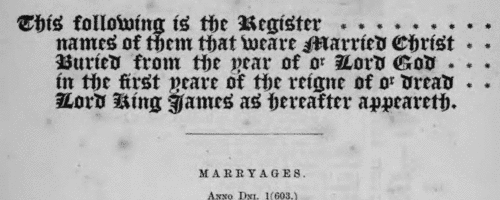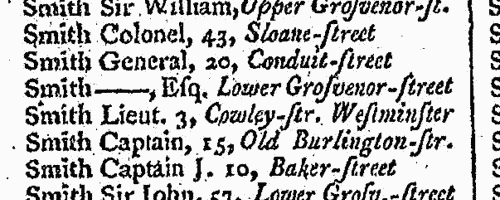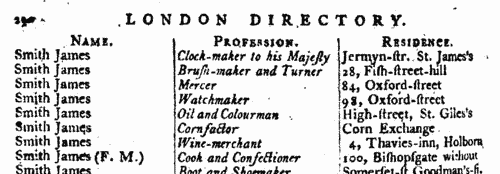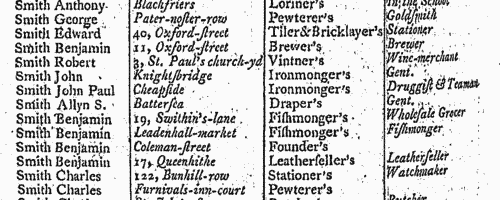Add this eBook to your basket to receive access to all 112 records. Our indexes include entries for the spelling darvill. In the period you have requested, we have the following 112 records (displaying 21 to 30): These sample scans are from the original record. You will get scans of the full pages or articles where the surname you searched for has been found. Your web browser may prevent the sample windows from opening; in this case please change your browser settings to allow pop-up windows from this site. Wandsworth Burials
(1771)
The ancient parish of Wandsworth in Surrey comprised the single township of Wandsworth, including the hamlets of Garratt, Half Farthing and Summers Town. It lay in the archdeaconry of Surrey of the diocese of Winchester: unfortunately, few bishop's transcripts of Surrey parish registers survive earlier than 1800. Although the original parish registers of Wandsworth doubtless commenced in 1538, the volume(s) before 1603 had been lost by the 19th century. In 1889 a careful transcript by John Traviss Squire of the first three surviving registers was printed, and we have now indexed it year by year. From 1760 onwards the burial registers contain date of burial, and full name; for the burial of children, the parents' names are also stated; for the burial of wives, the husband's name; ages are given for adults. Extra details such as date or cause of death, address or occupation are almost never given. The burial registers are considerably more bulky than the baptism registers, because the burying ground was used by Dissenters, who formed a large part of the population. These include a French Protestant congregation that worshipped in a church (the registers of which do not survive) in a courtyard immediately opposite the parish church. The Quakers had a cemetery of their own. The 18th-century burial registers also include a surprising number of children sent out to Wandsworth from London to nurse. | Sample scan, click to enlarge

|  Apprentices
(1774) Apprentices
(1774)
Apprenticeship indentures and clerks' articles were subject to a 6d or 12d per pound stamp duty: the registers of the payments usually give the master's trade, address, and occupation, and the apprentice's name, as well as details of the date and length of the apprenticeship. 1 January to 31 December 1774. | Sample scan, click to enlarge

|  Apprentices
(1777) Apprentices
(1777)
Apprenticeship indentures and clerks' articles were subject to a 6d or 12d per pound stamp duty: the registers of the payments usually give the master's trade, address, and occupation, and the apprentice's name, as well as details of the date and length of the apprenticeship. 2 January to 31 December 1777. IR 1/29 | Sample scan, click to enlarge

|  Masters of clerks and apprentices
(1780) Masters of clerks and apprentices
(1780)
Apprenticeship indentures and clerks' articles were subject to a 6d or 12d per pound stamp duty: the registers of the payments usually give the master's trade, address, and occupation, and the apprentice's name, as well as details of the date and length of the apprenticeship. 3 January to 30 December 1780. IR 1/30 | Sample scan, click to enlarge

|  Clerks and apprentices
(1788) Clerks and apprentices
(1788)
Apprenticeship indentures and clerks' articles were subject to a 6d or 12d per pound stamp duty: the registers of the payments usually give the master's trade, address, and occupation, and the apprentice's name, as well as details of the date and length of the apprenticeship. 2 January to 23 August 1788. IR 1/33 | Sample scan, click to enlarge

| London nobility and gentry
(1791)
The Universal British Directory includes a list of the nobility, gentry, &c. in London and Westminster: esquires, i. e., gentlemen without titles, are sometimes listed without their christian names. | Sample scan, click to enlarge

| Traders and Merchants in London
(1791)
The Universal British Directory was published in five volumes, starting in 1791. The professions included in the London section are very diverse: the addresses are mostly from central London. Some are marked 'F. M.', meaning Freeholder of Middlesex. | Sample scan, click to enlarge

| Members of London livery companies
(1791-1797)
One of the most useful sections of the Universal British Directory, nominally produced in 1791 but including later material, is a List of the Livery of London, giving the names and addresses of members of the London livery companies, together with their professions. As a glance at the sample will show, the companies and the professions only sometimes match, so this is an invaluable key as a first step in tracing the relevant company records for a London trader of this period | Sample scan, click to enlarge

|  Apprentices and clerks
(1802) Apprentices and clerks
(1802)
Apprenticeship indentures and clerks' articles were subject to a 6d or 12d per pound stamp duty: the registers of the payments usually give the master's trade, address, and occupation, and the apprentice's name, as well as details of the date and length of the apprenticeship. 3 June to 31 December 1802. IR 1/39 | Sample scan, click to enlarge

| Traders and professionals in London
(1805)
Holden's Triennial Directory for 1805 to 1807 includes this 'London Alphabet of Businesses, Professions, &c.': coverage is good; about 30,000 individuals are recorded. | Sample scan, click to enlarge

|
Research your ancestry, family history, genealogy and one-name study by direct access to original records and archives indexed by surname.
|












